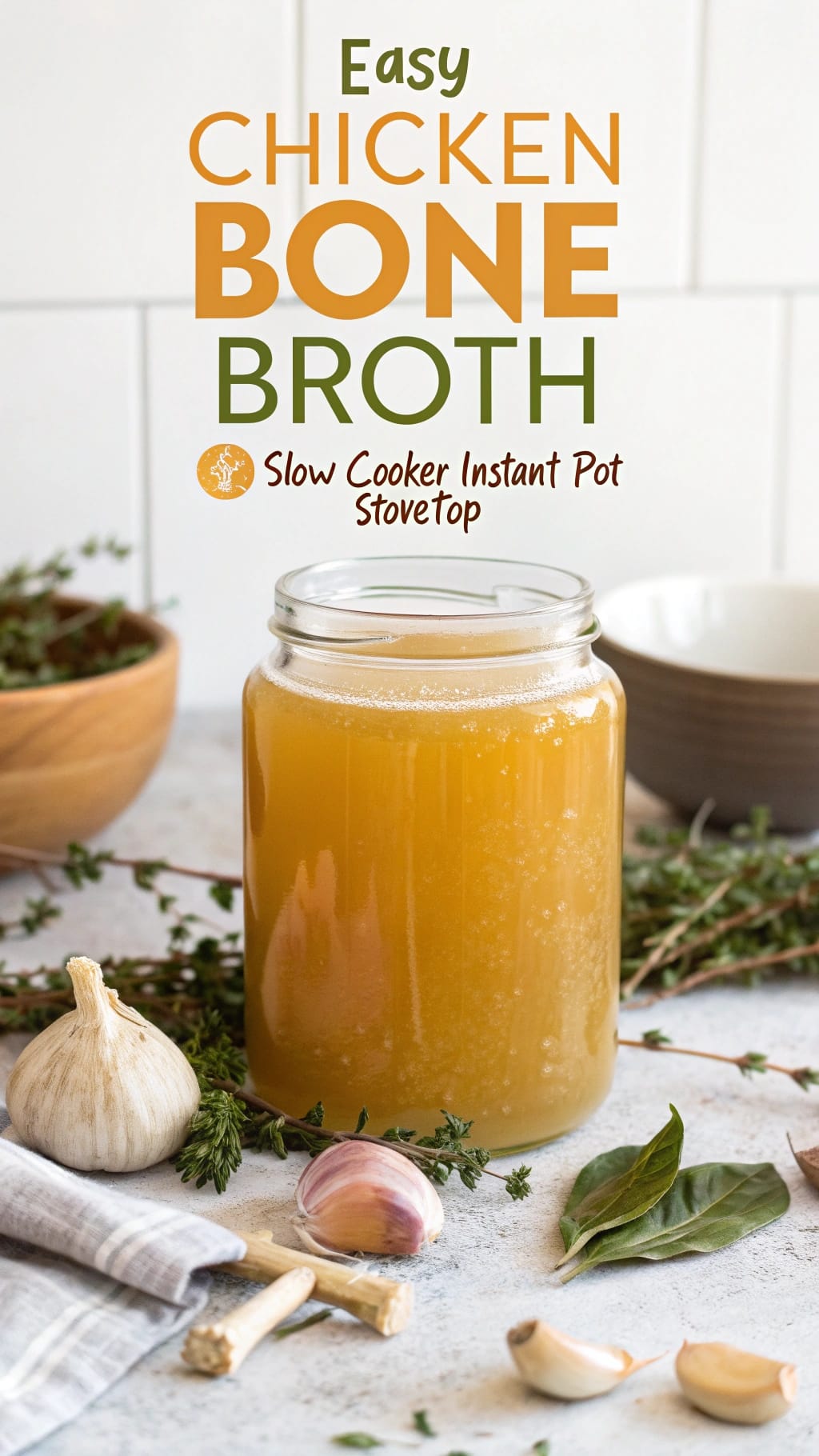Easy Chicken Bone Broth Recipe (Slow Cooker, Instant Pot, Stovetop)
There’s something deeply nourishing about a steaming mug of homemade chicken bone broth. Beyond its rich flavor that store-bought versions simply can’t match, this liquid gold offers impressive nutritional benefits that have made it increasingly popular among health enthusiasts, especially those following carnivore and keto lifestyles. Whether you’re looking to support gut health, boost collagen intake, or simply enhance your cooking, learning how to make chicken bone broth at home is a game-changer.
In this comprehensive guide, I’ll walk you through three simple methods to create delicious, nutrient-dense chicken bone broth using equipment you likely already have in your kitchen. The beauty of homemade broth is its adaptability – whether you follow a standard, keto, or strict carnivore approach, you can customize this recipe to perfectly align with your dietary preferences.
Table of Contents

Why Make Homemade Chicken Bone Broth? (Benefits)
Before diving into the recipe, let’s explore why making your own chicken bone broth is worth the effort:
Superior Flavor
There’s simply no comparison between homemade and store-bought broths. The depth, richness, and complexity of flavor in homemade chicken bone broth elevate any dish it touches. The slow extraction process allows for a fuller development of flavors that mass-produced versions can’t replicate.
Nutrient Density
Chicken bone broth is particularly rich in:
- Collagen and Gelatin: Chicken bones, especially joints and feet, release collagen during cooking, which transforms into gelatin – supporting skin health and potentially reducing joint pain.
- Minerals: Including calcium, magnesium, phosphorus, and potassium in forms your body can readily absorb.
- Amino Acids: Such as glycine and proline, which support detoxification, digestion, and immune function.
Gut Health Support
The gelatin in chicken bone broth supports digestive health by helping to restore the gut lining and reducing inflammation. This makes it particularly valuable for those dealing with digestive issues or following healing protocols like the carnivore diet.
Joint Health
The collagen extracted from chicken bones, cartilage, and connective tissues may help reduce joint pain and improve mobility – making bone broth a favorite among athletes and those with joint concerns.
Control Over Ingredients
Perhaps most importantly, making broth at home puts you in complete control of what goes into it. No preservatives, additives, excess sodium, or mystery ingredients – just pure, wholesome nutrition.
For a deeper understanding of the differences between bone broth, stock, and regular broth, check out our comprehensive comparison at Bone Broth vs Stock vs Broth.

Ingredients for Easy Chicken Bone Broth
Chicken Bones (The Key!)
The foundation of any good bone broth is, of course, the bones. For chicken bone broth, you’ll need approximately 2-3 pounds (1-1.5 kg) of bones. The best options include:
- Chicken carcasses: Leftover from roasted chickens (save those rotisserie chicken remains!)
- Backs and necks: These are often inexpensive at butcher shops
- Wings: Rich in collagen
- FEET: Don’t skip these if available! Chicken feet are collagen powerhouses that significantly enhance the gelatin content in your broth
For optimal nutrition and flavor, seek out pasture-raised chicken bones whenever possible. The quality of your bones directly impacts the quality of your broth.
Water
Use filtered water if available, as chlorine and other chemicals in tap water may affect the flavor. You’ll need enough to cover your bones by 1-2 inches – approximately 3-4 quarts (3-4 liters) for a standard batch.
Salt
Unrefined salt like sea salt or Himalayan pink salt is recommended. Add to taste, starting with a small amount (1-2 teaspoons) as you can always adjust later.
Apple Cider Vinegar (ACV) – Optional
Adding 1-2 tablespoons of apple cider vinegar helps extract minerals from the bones. The mild acidity breaks down the bones more effectively, though the final broth won’t taste vinegary.
Aromatics (Optional – Customize for Diet!)
This is where you can truly personalize your broth based on your dietary approach:
Traditional Aromatics:
- 1 onion, quartered (no need to peel)
- 2-3 carrots, roughly chopped
- 2-3 celery stalks, roughly chopped
- 4-6 garlic cloves, smashed
- Fresh parsley stems
- 1-2 bay leaves
- 1 tablespoon whole peppercorns
Keto/Low-Carb Option:
- Use minimal onion/celery/garlic only for flavor infusion
- Remove vegetable matter before final storage
- OMIT carrots entirely (higher in carbs)
Carnivore Option:
- OMIT ALL aromatics/vegetables
- Use only bones, water, salt, and optional ACV
For a strict carnivore approach to bone broth, check out our dedicated guide: Carnivore Bone Broth Recipe.

How to Make Chicken Bone Broth: Step-by-Step
Step 1: Prepare the Bones (Optional Blanching/Roasting)
Blanching (Optional):
This step helps remove impurities for a clearer, cleaner-tasting broth:
- Place bones in a large pot and cover with cold water
- Bring to a boil over high heat
- Simmer for 10-15 minutes
- Drain and rinse bones under cool water
Roasting (Optional):
Roasting adds depth and complexity to your broth:
- Preheat oven to 400°F (200°C)
- Spread bones on a baking sheet
- Roast for 20-30 minutes until golden brown
- For extra flavor, add a light drizzle of oil before roasting
Step 2: Choose Your Method
Slow Cooker / Crock Pot Instructions:
- Place prepared bones in slow cooker
- Add apple cider vinegar and let sit for 15-30 minutes (helps extract nutrients)
- Add optional aromatics and salt
- Cover with filtered water, leaving 1-inch headspace
- Cook on LOW for 12-24 hours (longer cooking = richer broth)
- Skim off any foam or scum that rises to the surface if desired
Instant Pot / Pressure Cooker Instructions:
- Place prepared bones in Instant Pot
- Add apple cider vinegar and let sit for 15-30 minutes
- Add optional aromatics and salt
- Cover with filtered water (respect the MAX line!)
- Secure lid and set valve to sealing position
- Cook on HIGH pressure for 90-120 minutes (2 hours yields excellent results)
- Allow for Natural Pressure Release (NPR)
Stovetop Instructions:
- Place prepared bones in a large stockpot
- Add apple cider vinegar and let sit for 15-30 minutes
- Add optional aromatics and salt
- Cover with filtered water
- Bring to a boil, then immediately reduce to lowest possible simmer
- Cook partially covered for 6-12 hours
- Skim foam occasionally and add water if needed to keep bones submerged
Step 3: Strain the Broth
- Place a fine-mesh sieve over a large bowl or pot
- Line with cheesecloth for ultra-clear broth (optional)
- Carefully pour broth through the sieve
- Discard solids (or remove meat for other uses if desired)
Step 4: Cool & Store
- Cool broth to room temperature (no longer than 2 hours for food safety)
- For defatting (optional):
- Refrigerate overnight
- Remove solidified fat layer from the top
- Save the fat (schmaltz) for cooking – it’s delicious for sautéing vegetables!
- Storage options:
- Refrigerator: 4-5 days in airtight containers
- Freezer: Up to 6 months in freezer-safe containers
- Leave 1-inch headspace for expansion when freezing
Tips for Perfect Chicken Bone Broth
Use Chicken Feet for Maximum Gel!
I can’t emphasize this enough – if you want that perfect jiggly, gelatin-rich broth, chicken feet are the secret ingredient. They contain more collagen than any other part, resulting in a lusciously thick broth with maximum nutritional benefits.
Don’t Boil Vigorously
Keep your broth at a gentle simmer. Vigorous boiling can break down the proteins improperly, resulting in cloudy broth with off flavors.
Salt to Taste at the End
While you can add a small amount of salt at the beginning, adjust the final seasoning after the broth has been reduced and strained. This prevents over-salting as the liquid concentrates during cooking.
Storing & Freezing Properly
For convenient use:
- Freeze in silicone ice cube trays for small portions (perfect for cooking)
- Use mason jars for refrigerator storage (leave headspace if freezing)
- Label with date and ingredients for easy identification
How to Use Chicken Bone Broth
Once you’ve mastered making chicken bone broth, here are delicious ways to incorporate it into your low-carb or carnivore lifestyle:
Sipping Plain
Perhaps the simplest way to enjoy bone broth is to heat it up, add a pinch of salt, and sip it as a nourishing beverage. Many people enjoy this as part of their morning routine or as an afternoon pick-me-up.
Base for Keto/Low-Carb Soups
Use your homemade broth as the foundation for delicious soups like:
- Keto Ground Beef Soup
- Bacon Cheeseburger Soup
- Chicken “noodle” soup with zucchini or cabbage “noodles”
Cooking Liquid for Low-Carb Vegetables
Replace water with bone broth when cooking cauliflower rice or steaming vegetables for an incredible flavor boost without adding carbs.
Poaching Chicken Breasts
For incredibly tender and flavorful chicken, poach chicken breasts in your homemade broth instead of water.
Making Keto-Friendly Sauces and Gravies
Reduce bone broth to intensify its flavor and use as a base for low-carb gravies and sauces – perfect for enhancing carnivore chicken recipes.
Chicken Bone Broth FAQ
Can I use a rotisserie chicken carcass?
Absolutely! Rotisserie chicken carcasses make excellent bone broth. Simply remove the majority of the meat for other meals, then use the remaining carcass with bones, skin, and cartilage for your broth. This is an economical way to get multiple meals from one chicken.
How long does chicken bone broth really need to cook?
While chicken bones can release good flavor and some nutrients in as little as 2-3 hours, the magic happens with longer cooking times:
- Minimum recommended: 6 hours
- Optimal range: 12-24 hours
- The longer you cook, the more minerals and collagen you’ll extract
My broth didn’t gel, what went wrong?
If your broth stays liquid rather than developing that prized jelly-like consistency when refrigerated, likely causes include:
- Not enough collagen-rich parts (feet, wings, joints)
- Too much water relative to bones
- Vigorous boiling breaking down the gelatin
- Insufficient cooking time
Try adding chicken feet to your next batch for a guaranteed gel!

Conclusion
Making your own chicken bone broth at home is a simple yet powerful way to enhance your nutrition while creating a versatile cooking ingredient. Whether you prefer the set-it-and-forget-it approach of a slow cooker, the speed of an Instant Pot, or the traditional stovetop method, you now have all the knowledge needed to create perfect bone broth every time.
The benefits extend far beyond flavor – from supporting gut health to providing easily absorbed nutrients that complement a keto or carnivore lifestyle. Plus, there’s something deeply satisfying about transforming kitchen scraps into liquid gold that nourishes your body from the inside out.
Have you tried making chicken bone broth at home? We’d love to hear about your experience, favorite method, or any special ingredients you add to make it your own. Share your results in the comments below!
Want to learn if bone broth breaks a fast? Check out our article: Does Bone Broth Break a Fast?
External Resources:
- Harvard Health: What’s the scoop on bone soup?
- National Library of Medicine: Traditional bone broth in modern health and disease
Enjoy, Review – We Value Your Opinion!
There are no reviews yet. Be the first one to write one.

